McLaren Senna to hit 0-62mph in 2.8secs 07 | 02 | 2018
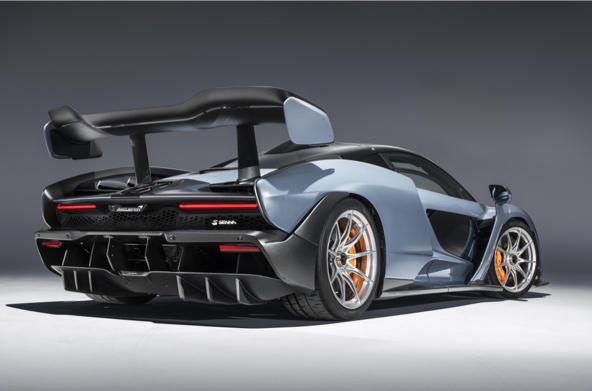
McLAREN HAS RELEASED performance figures for its sold out, £750,000 Senna hypercar. The track-focused, 789bhp model is capable of 0-62mph in 2.8 seconds and hits a top speed of 211mph. (Related: Roadtest — McLaren 720S)
Powered by its 4.0-litre twin-turbo V8, allied to its 1198kg kerbweight (about the same as a Ford Focus), the McLaren Senna can also complete the standing quarter mile in 9.9 seconds, which is faster than the original McLaren F1.
But while the new model is fast, it’s stopping power is equally impressive. Thanks to its motorsport-grade braking system, the Senna will stop from 124mph in just 100 metres. (Related: McLaren unveils 789bhp Senna hypercar)
Named after three-time Formula 1 World Champion Ayrton Senna, a portion of the car’s profits will go to the foundation set up in his name.
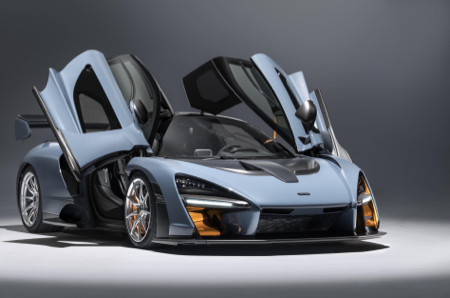
“The McLaren Senna honours my uncle because it is so utterly focused upon the driver, and their absolute connection with the vehicle,” Bruno Senna, racing driver, nephew of Ayrton Senna and McLaren ambassador, said. “This engagement, these sensory cues that the driver responds to and relies upon, the whole immersive experience, has been at the heart of the development from the very start.”
Just 500 will be built, each hand-assembled in a 300-hour process at the McLaren Production Centre in Woking, Surrey.
But the true depth of the performance credentials of the new Ultimate Series McLaren will only be revealed when it calls on downforce of up to 800kg on a circuit, against the stop-watch.
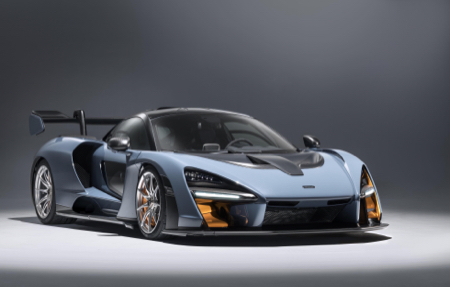
“The McLaren Senna is a car like no other: the personification of McLaren’s motorsport DNA, legalised for road use but designed and developed from the outset to excel on a circuit,” Mike Flewitt, Chief Executive Officer, McLaren Automotive, said.
“Every element of this new Ultimate Series McLaren has an uncompromised performance focus, honed to ensure the purest possible connection between driver and machine and deliver the ultimate track driving experience in the way that only a McLaren can.”
The McLaren Senna combines low vehicle weight, extreme power, aerodynamic excellence and a revolutionary, active suspension system to deliver the most responsive and engaging road car experience to date from the British luxury sportscar and supercar maker.
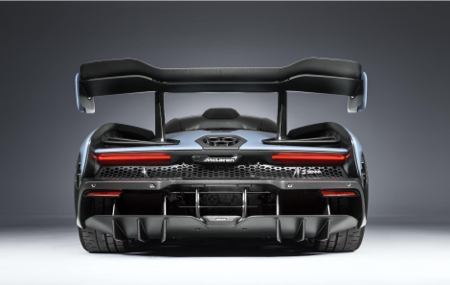
“The design language of the McLaren Senna is extremely aggressive and different from any previous McLaren – because no other road-legal McLaren has had to fulfil such an uncompromising brief,” explained Rob Melville, design director, McLaren Automotive, said.
“When you see the car for the first time, you know instantly how single-minded and focused it is; to meet the performance targets we have had to go to an entirely different level from even the McLaren P1.”
Precise control of airflow begins the moment it hits the nose of the car, the air meeting four surfaces – front splitter; active aero blades; secondary fixed aero blades and slot-gaps located between the headlights and daytime running lights – and being turned by each element in sequence.
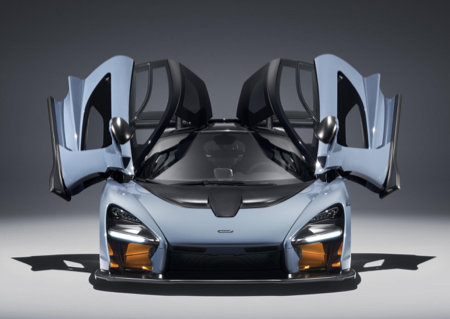
The design of the rear of the car was born entirely from aerodynamic and cooling requirements, prominent ‘gurney flaps’ ahead of a succession of stepped louvres directing air away from the rear deck and down the sides of the body.
The resulting area of low pressure draws hot air out from the high-temperature radiators and engine bay, the louvres ensuring that airflow does not impact rear wing efficiency. Unique slash-cut exhausts make a similar airflow contribution, their positioning and angle negating any disturbance to the wing or rear diffuser.
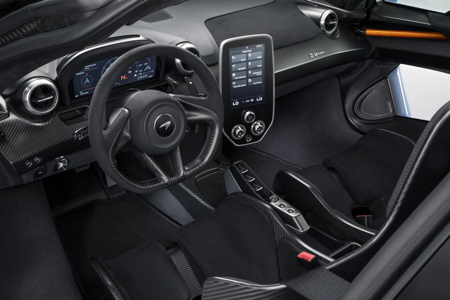
The exhaust pipes exit through the lowest rear deck (measured at the trailing edge) of any McLaren road car, a full 18cm lower than the McLaren Super Series. In contrast to the ultra-low rear deck, the hydraulically-operated, double-element carbon fibre rear wing – a major contributor to the downforce generated – is noticeably high and constantly adjusts to optimise downforce and maintain ideal aerodynamic balance. The wing weighs just 4.87kg, yet can support more than 100 times its own weight in downforce.
The double diffuser at the rear is equally prominent; crafted from a single piece of carbon fibre, it starts under the rear axle and as it increases in height accelerates air out from under the vehicle. This creates a low-pressure zone and ‘sucks’ the McLaren Senna to the ground.
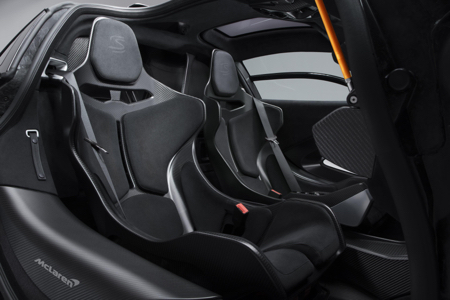
The Monocage III carbon structure at the centre of the McLaren Senna is the strongest carbon fibre monocoque ever created by McLaren for a road car and features an innovative double-walled rear assembly that provides an in-built protective roll cage. Monocage III is optimised to create the lightest structure possible and is one of the reasons why, at 1198kg, the McLaren Senna is the lightest road car McLaren has built since the F1.
The benefits of carbon fibre are felt throughout the McLaren Senna. The body panels, which have the immense structural rigidity needed to support the aerodynamic forces they are subjected to at high speeds on a race track, are incredibly strong and lightweight. In total, the carbon fibre body panels of the McLaren Senna weigh less than 60kg.
Carbon fibre and Alcantara are used extensively throughout the interior, reflecting the stripped-back, functional nature of the Senna. The dashboard, doors and visible elements of the Monocage III are all in exposed carbon fibre. Alcantara (or leather if preferred) covers the side airbags and the lack of further interior trim saves weight and reveals the construction of the dihedral doors. Even the door gas struts, which can be colour-matched to the brake calipers and front active aero blades, are exposed to save vital grammes.
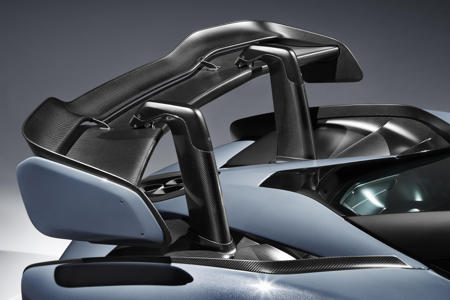
Inside the cabin, the driver’s seat moves on rails and the foot pedals are fixed – the optimum solution to reduce component complexity and weight. The module to select Drive, Neutral and Reverse is fixed to the driver’s seat and moves with it, ensuring the controls are always close at hand.
Door release mechanisms and window switches have been moved to the centre of the vehicle in a roof-mounted panel. The three-spoke steering wheel, trimmed in Alcantara or leather, is free of buttons and switches to allow a pure focus on the sensory feedback it delivers.
The grip offered with and without gloves has been optimised for track driving, as has the design of the wheel itself. Tactile, extended gear shift paddles in satin-finish visual carbon fibre, linked with a rocker switch, are fixed behind the steering wheel.
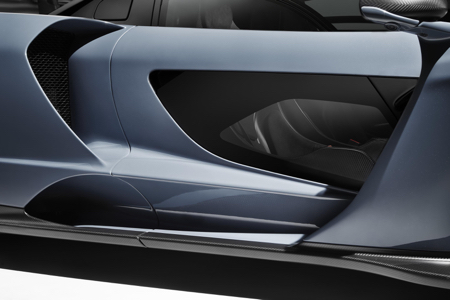
The ‘floating’ central infotainment screen is presented in portrait to increase interior space. It is also angled out and up towards the driver to be easily visible within line of sight even when a helmet is being worn.
The edge-to-edge glass screen integrates the Active Dynamics Panel and an 8-inch display that presents vehicle functions to the driver: audio, media, navigation and other features are all controlled using this TFT screen.
A range of luxury and convenience features are available upon request, including high-grade leathers and a wider ‘Touring’ specification of the Super-Lightweight carbon fibre seat. Parking sensors and a rear-view camera are no-cost options.
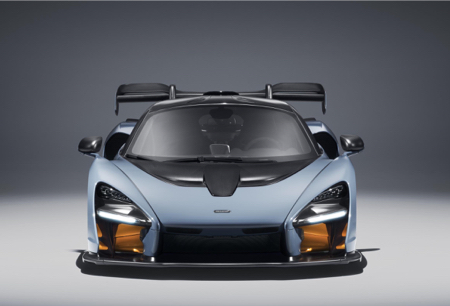
Additionally, McLaren has collaborated with Bowers & Wilkins to create an audio system specifically designed for the McLaren Senna, the optional, ultra-lightweight 7-speaker audio system weighing just 7.32kg.
“The McLaren Senna delivers real performance – accessible and attainable because of an intuitive connection, while at the same time rewarding, exciting and challenging to the very best drivers in the world,” Andy Palmer, vehicle line director - Ultimate Series, McLaren Automotive, said.
“The sensory experience of driving the car is also vitally important: through what a driver feels, hears and sees, we want every moment behind the wheel of a McLaren Senna to deliver the emotional intensity of a convertible and the pure connection of a race car.”
Although all 500 examples have been allocated to buyers, the first public debut of the Senna will be at next month’s Geneva Motor Show.
Related: Roadtest — McLaren 570GT
Keep up-to-date with all the latest news by following us on twitter.com/Scotcars
Jim McGill